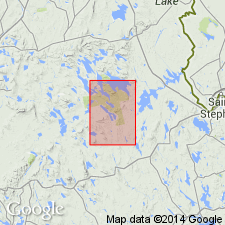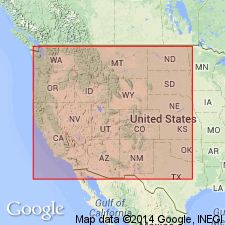
- Usage in publication:
-
- Bottle Lake Quartz Monzonite*
- Modifications:
-
- Named
- Dominant lithology:
-
- Quartz monzonite
- AAPG geologic province:
-
- New England province
Summary:
Bottle Lake Quartz Monzonite. Gray and pink porphyritic quartz monzonite. Northeastern tip of pluton, extending into Waite quadrangle, is referred to as Topsfield granitic facies. This facies is chiefly leucocratic pink aggregate of microcline, quartz, plagioclase, with little muscovite, and less biotite or hornblende. A gradational change from normal quartz monzonite to the pink Topsfield facies may be in vicinity of Vickery Brook, Scraggly Lake quadrangle. On map legend the Bottle Lake is placed above Wabassus Quartz Monzonite (new) but relationship to the Wabassus not discussed. Potassium-argon age of sample from Bottle Lake locality is about 342 m.y. Age of sample from road from West Musquash Lake to Upper Oxbrook Lake, Scraggly Lake quadrangle, about 370 m.y. by potassium-argon method or 380 m.y. by lead-alpha method. Age is Devonian.
Type locality: 1 mi northwest of Bottle lake, along road from Springfield southerly to that lake, Springfield quadrangle, Washington Co., eastern ME. Pluton extends from Waite quadrangle southwestward and westward into Scraggly Lake, Springfield, Winn, Wabassus Lake, Nicatous Lake, and Saponac quadrangles, Washington Co., eastern ME.
Source: US geologic names lexicon (USGS Bull. 1350, p. 85).

- Usage in publication:
-
- Bottle Lake Quartz Monzonite*
- Modifications:
-
- Geochronologic dating
- AAPG geologic province:
-
- New England province
Summary:
Pg. 17-18, geologic time scale (inside front cover). Bottle Lake Quartz Monzonite. Granite sample from Topsfield granitic facies (Larrabee and others, 1965, USGS Bull. 1201-E), 4.8 km north of Topsfield, along U.S. Route 1, Waite quadrangle, Washington County, Maine, yielded U-Th-Pb ages from 404 +/-4 Ma to 377 +/-4 Ma. Ages calculated using decay constants of Steiger and Jager, 1977 (Earth Planet. Sci. Letters, v. 36, p. 359-362). Faul and others (1963) reported biotite K-Ar age of 380 Ma (recalculated to decay constants of this paper) and zircon Pb-alpha age of 400 Ma. Locality lies in area that may have experienced delayed cooling and, consequently, delayed argon retention in the biotite.
Source: Publication.
For more information, please contact Nancy Stamm, Geologic Names Committee Secretary.
Asterisk (*) indicates published by U.S. Geological Survey authors.
"No current usage" (†) implies that a name has been abandoned or has fallen into disuse. Former usage and, if known, replacement name given in parentheses ( ).
Slash (/) indicates name conflicts with nomenclatural guidelines (CSN, 1933; ACSN, 1961, 1970; NACSN, 1983, 2005, 2021). May be explained within brackets ([ ]).

